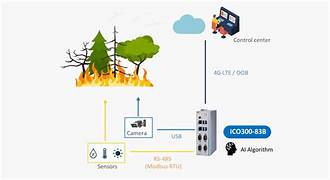AI-Driven Strategies for Wildfire Prediction and Management: A Comprehensive Guide
Wildfires have become one of the most devastating natural disasters in recent years, causing widespread destruction to ecosystems, property, and human lives. The increasing frequency, intensity, and unpredictability of wildfires, exacerbated by climate change, have made it more urgent than ever to develop innovative strategies for wildfire prediction and management. Artificial Intelligence (AI) has emerged as a powerful tool in addressing these challenges, offering new ways to predict, prevent, and manage wildfires more effectively. This article explores the various AI-driven strategies that are transforming wildfire prediction and management, from early detection to post-fire recovery.
1. AI-Powered Fire Prediction Models
Accurate fire prediction is one of the key components in mitigating the impact of wildfires. AI-based models are helping scientists and emergency response teams predict where and when wildfires are likely to occur. These models analyze large volumes of historical and real-time data, such as weather patterns, topography, vegetation, and human activity, to forecast wildfire risks with high precision.
Machine learning (ML) algorithms, a subset of AI, are used to identify patterns in historical wildfire data, including temperature, humidity, wind speed, and fuel moisture levels. By learning from this data, AI models can recognize conditions that are conducive to wildfire ignition and spread. In combination with satellite imagery and geographic information system (GIS) data, these models can predict wildfire risks on a regional or local scale, providing valuable insights to authorities and emergency responders.
2. Satellite and Drone Surveillance for Early Detection
Early detection of wildfires is critical in preventing them from spreading uncontrollably. AI has enhanced the capabilities of satellite and drone surveillance, enabling real-time monitoring of vast areas and prompt identification of new fires. AI-powered image recognition systems analyze data collected by satellites and drones to detect signs of smoke, heat, and fire at the earliest stages.
For example, AI algorithms process thermal infrared imagery from satellites to detect hotspots or rising temperatures in forests and other high-risk areas. By identifying anomalies that may indicate a fire, these AI systems allow responders to take swift action, reducing the time it takes to contain the blaze. Drones equipped with AI-powered cameras and sensors can also be deployed to monitor remote or hard-to-reach areas, further enhancing the effectiveness of early detection.
3. Predicting Fire Behavior and Spread
Once a wildfire has been detected, understanding its behavior and potential spread is crucial for effective management. AI is playing a vital role in predicting fire behavior, which helps responders deploy resources efficiently and reduce the risk of loss of life and property. By analyzing data from various sources, including weather forecasts, topography, vegetation types, and fuel moisture levels, AI models can simulate how a wildfire will spread under different conditions.
These models rely on advanced algorithms that can process large amounts of dynamic data and calculate the potential path of the fire. For example, AI systems can predict how wind speed, temperature, and humidity will affect the fire’s intensity and direction. This helps fire management teams plan evacuation routes, deploy firefighting resources, and establish containment lines in the most vulnerable areas.
AI can also be used to predict fire intensity, which is a key factor in determining the level of resources required to control the blaze. By accurately forecasting the fire’s behavior, AI can help responders prioritize actions and deploy firefighting efforts where they are most needed, ultimately reducing the damage caused by the fire.
4. AI-Enhanced Firefighting Robots and Drones
In recent years, AI-driven firefighting robots and drones have been developed to assist in controlling and extinguishing wildfires. These robots, equipped with AI-based decision-making algorithms, can be deployed in hazardous environments that may be too dangerous for human firefighters. For example, autonomous robots can be used to create firebreaks, clear vegetation, or extinguish flames using water or fire retardant.
AI-driven drones can be used in tandem with robots to monitor fire behavior from the air, deliver supplies to firefighters in remote areas, or even drop fire retardants in hard-to-reach locations. These robots and drones can operate autonomously, making real-time decisions based on AI algorithms, such as adjusting their path based on changing fire conditions or identifying the most efficient way to reach a target location.
By augmenting the capabilities of human firefighters and providing a new level of precision and speed in firefighting efforts, AI-driven robots and drones are transforming wildfire management, especially in situations where human safety is a concern.
5. AI for Resource Allocation and Emergency Response
Efficient allocation of firefighting resources is crucial for managing large-scale wildfires. AI-powered decision support systems are helping fire management agencies optimize resource allocation by analyzing data from a variety of sources, such as weather forecasts, fire behavior predictions, and available personnel and equipment.
Machine learning models can help decision-makers predict the number of resources (e.g., fire trucks, helicopters, firefighters) needed at different locations based on the fire’s behavior and anticipated spread. These AI systems can also recommend the best tactics for containment, such as where to establish firebreaks, which areas require immediate attention, and how to prioritize evacuation efforts.
In addition, AI can be used to optimize logistics by analyzing traffic patterns and identifying the most efficient routes for transporting personnel, equipment, and supplies. This can significantly reduce response times, increase the effectiveness of firefighting efforts, and ensure that resources are deployed in the most strategic locations.
6. AI for Post-Fire Recovery and Damage Assessment
Once a wildfire has been contained, assessing the damage and planning for recovery are critical steps in the disaster management process. AI technologies can aid in post-fire recovery by quickly analyzing damage using satellite imagery, aerial drones, and ground-level sensors.
AI algorithms can process satellite images to identify areas that have been severely impacted by the fire, such as burned forests, damaged infrastructure, and disrupted ecosystems. This data can then be used to inform recovery efforts, such as prioritizing areas for reforestation, rebuilding, or restoring natural habitats. AI can also help track the progress of recovery efforts by analyzing the effectiveness of restoration techniques and recommending adjustments to improve outcomes.
Moreover, AI can help assess the social and economic impacts of wildfires, such as identifying communities most in need of assistance or providing data for insurance claims. By supporting post-fire recovery, AI can accelerate the rebuilding process and minimize the long-term effects of wildfires.
7. AI in Community Awareness and Preparedness
Preventing wildfires requires not only advanced prediction and response strategies but also effective community awareness and preparedness. AI is being used to enhance public awareness programs, educate people about fire risks, and encourage preventive measures such as defensible space around homes or proper disposal of combustible materials.
AI-driven systems can be used to develop personalized fire risk reports for individuals and communities based on local conditions, such as weather, vegetation, and proximity to wildfire-prone areas. These systems can send alerts to residents, informing them of potential wildfire threats and providing recommendations on how to prepare or evacuate.
Additionally, AI can analyze historical wildfire data and social media posts to identify trends and potential fire hazards, helping to predict where public awareness campaigns may be most needed. By using AI to enhance community preparedness, authorities can empower residents to take proactive steps to protect their homes and reduce the risk of wildfire disasters.
8. Collaborative AI and Data Sharing for Global Wildfire Management
Wildfires are a global problem that requires international cooperation and data sharing. AI technologies are helping to connect various fire management agencies and stakeholders across borders by facilitating the sharing of real-time data, models, and insights. This collaborative approach enhances the ability to predict, manage, and respond to wildfires on a global scale.
AI can help integrate data from different countries, regions, and organizations, allowing for the development of comprehensive wildfire prediction models and coordinated response strategies. By sharing resources and knowledge, AI-driven collaboration helps to strengthen wildfire management efforts worldwide and foster a more resilient global response to climate change-related disasters.
Conclusion
AI is revolutionizing the way wildfires are predicted, managed, and mitigated. From advanced prediction models and early detection systems to autonomous firefighting robots and post-fire recovery strategies, AI technologies are transforming every aspect of wildfire management. As the frequency and severity of wildfires continue to increase, AI will play an increasingly important role in preventing, controlling, and recovering from these devastating disasters. By leveraging AI’s capabilities, fire management agencies can make better decisions, optimize resource allocation, and ultimately protect communities, ecosystems, and lives from the destructive impact of wildfires.


